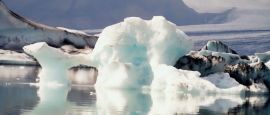Iceland has three national parks: Þingvellir (Thingvellir), Vatnajökull, and Snæfellsjökull. Þingvellir, arguably the most famous national park in Iceland, is a powerful visual representation of continental drift as the American and Eurasian tectonic plates below the surface are pulling apart at a rate of a few centimetres a year. On the other hand, Vatnajökull and Snaefellsjokull are famed for snow-capped volcanoes.
Iceland things to see and do
This 250km (155mi) sightseeing route starts from Akureyri and connects five major attractions: the picturesque Goðafoss Waterfall, the blue/green landscapes of Lake Mývatn, the powerful Dettifoss Waterfall, the horseshoe-shaped Ásbyrgi Canyon, and the whale-watching hub of Húsavík.
Arguably the most famous sightseeing route among tourists, the 300km (186mi) Golden Circle connects Þingvellir (Thingvellir National Park), Gullfoss and Geysir – the three must-see attractions for any tourist to south Iceland. Many companies offer this full-day tour from Reykjavík.
Iceland has many geothermal spas and the most famous ones are the Blue Lagoon and Sky Lagoon near Reykjavík. The former is covered in silica mud which is said to have skin-healing properties. The latter, launched in 2021 and is closer to Reykjavík than the Blue Lagoon, has an infinity pool and sauna that offer breathtaking views of the Atlantic Ocean.
The Hvitá River forces its way through the basalt lava layers and thunders down in two stages before dropping into a narrow canyon below. Visitors can walk the one-mile trail and see the cascades from the overlook.
At the edge of Vatnajökull National Park lies Jökulsárlón, a glacial lagoon formed in 1934 when Breiðamerkurjökull glacier started retreating. With floating icebergs and seals swimming in the lagoon, its surreal landscape makes it a favourite with photographers and film crews. Hollywood movies such as Die Another Day and Lara Croft: Tomb Raider were shot here.
One of nature's most awesome spectacles, the Northern Lights are visible from late September to mid-April across the Icelandic sky. The ever-shifting, glowing patterns of light are caused by the electrically charged particles colliding with the atmosphere. Sightings are weather dependent and not guaranteed.
The word "geyser" that we use to define a spouting hot spring comes from the Great Geysir in Hauka Valley, an area with many hot water blowholes. Within the geothermal park, the most active geyser is Strokkur, which erupts every 10-15 minutes or so.
Do you have any Feedback about this page?
© 2025 Columbus Travel Media Ltd. All rights reserved. No part of this site may be reproduced without our written permission, click here for information on Columbus Content Solutions.








 You know where
You know where